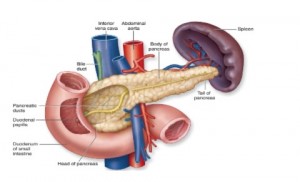What is diabetes and Cauases
CAUSES OF DIABETES
I have just been diagnosed with Type 2 diabetes and my doctor says it is because I have something called the Metabolic Syndrome. What does this mean and is it the cause of my diabetes? 
Metabolic syndrome is a group of conditions that are known to increase the risk of heart disease and stroke. There are a number of different definitions but they all emphasise that insulin resistance is the underlying cause. The cluster of problems called metabolic syndrome includes the following:
- central obesity (fat around the waist line)
- high blood pressure
- abnormal cholesterol (high LDL and low HDL fractions) and high levels of triglycerides
- Type 2 diabetes, impaired glucose tolerance (see link) – or at least a high risk of developing this
- fatty liver (see next question)
The insulin resistance means that if a person with metabolic syndrome does not have diabetes, their beta cells in the pancreas will be working overtime to produce high levels of insulin in order to keep the blood sugar level normal. There is a high chance that the beta cells will be unable to maintain this high output of insulin indefinitely and sooner or later the blood sugar level will rise, resulting in diabetes.
People with metabolic syndrome, whether or not they have diabetes, will probably be asked to take a number of tablets in order to correct the high blood pressure and abnormal cholesterol levels. The best treatment (though not always the easiest) is to reduce weight and overcome the central obesity.
My doctor carries out regular tests for diabetes. This is because I have a condition called fatty liver, which he says puts me at risk of developing diabetes in the future.
The medical name for this condition is Non-Alcoholic Fatty Liver Disease (NAFLD) and it describes a range of conditions in which the liver tests are abnormal in people who drink little or no alcohol. It ranges from a mild condition in which excess fat is deposited in the liver causing slightly abnormal liver tests to a more serious condition in which the fat in the liver leads to inflammation, scarring and cirrhosis, which is irreversible liver damage. NAFLD is very common and may be found in up to 1 in 5 adults. Of those with NAFLD, about 1 in 4 will develop the more serious form leading to cirrhosis. This is a very slow process and may progress over years to liver failure. It is related to obesity and as in the metabolic syndrome (see previous question) insulin resistance is the underlying cause. There is no proven treatment for this condition, apart from weight reduction, which results in rapid improvement in the abnormal liver tests. However in trials glitazones have been shown to improve liver tests and are beginning to be used in ordinary practice. Unfortunately they do have the effect of making people put on weight, which is often disappointing.
POSTED ON October 31, 2014,